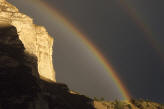Glacier National Park provides a
wonderful opportunity to view animals in their natural setting. Along with
this opportunity comes a special obligation for the visitor. With just a
little planning and forethought, hikers can also help ensure the survival
of a protected threatened species.
Donít Surprise Bears!
Bears will usually move out of the way if they hear
people approaching, so make noise. Most bells are not loud enough. Calling
out or clapping hands loudly at regular intervals are better ways to make
your presence known. Hiking quietly endangers you, the bear, and other
hikers.
When bears charge
hikers, the trail may be temporarily closed for public safety. While the
trail remains closed, other visitors miss the opportunity to enjoy it. A
bear constantly surprised by people may become habituated to close human
contact and less likely to avoid people. This sets up a dangerous
situation for both visitors and bears.
Donít Make Assumptions!
You canít predict when and where bears might be
encountered along a trail. People often assume they donít have to make
noise while hiking on a well-used trail. Some of the most frequently used
trails in the park are surrounded by excellent bear habitat. People have
been charged and injured by bears fleeing from silent hikers who
unwittingly surprised bears along the trail. Even if other hikers haven't
recently seen bears along a trail section recently, donít assume there are
no bears present.
Donít assume a
bearís hearing is any better than your own. Some trail conditions make it
hard for bears to see, hear, or smell approaching hikers. Be particularly
careful by streams, against the wind, or in dense vegetation. A blind
corner or a rise in the trail also requires special attention.
Keep children
close by. If possible, hike in groups and avoid hiking early in the
morning, late in the day, or after dark. Do not hike alone.
Inform Yourself About
Bears
Park staff can help you identify signs of bear
activity such as tracks, torn-up logs, diggings, trampled vegetation,
droppings, and overturned rocks. Bears spend a lot of time eating, so
avoid hiking in obvious feeding areas like berry patches, cow parsnip
thickets, or fields of glacier lilies.
Don't Approach Bears!
Never intentionally get close
to a bear! Individual bears have their own personal space requirements
which vary depending on their mood. Each will react differently and their
behavior canít be predicted. All bears are dangerous and should be
respected equally.

